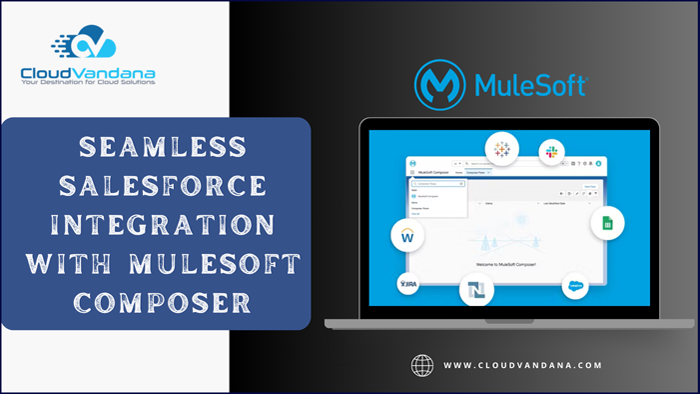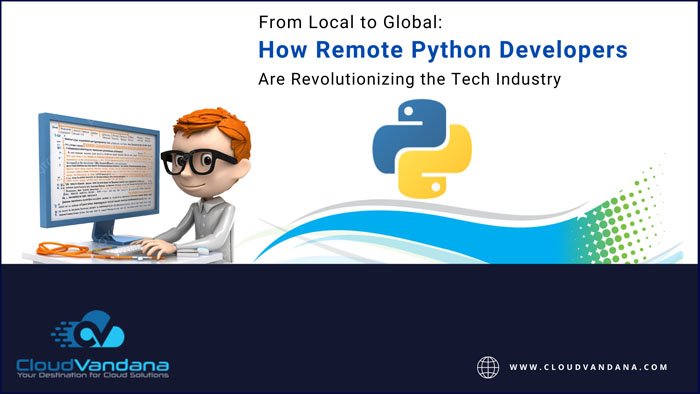Seamless Salesforce Integration with MuleSoft Composer: A No-Code Guide

Unlock the power of seamless Salesforce integration effortlessly with MuleSoft Composer! Explore this no-code guide for a step-by-step walkthrough, empowering you to effortlessly connect and streamline your business processes with MuleSoft Composer’s intuitive capabilities. As a leading CRM platform, Salesforce is pivotal in managing customer relationships. However, seamless integration with other applications and data sources is crucial to maximize its potential. Enter MuleSoft Composer – the no-code solution for Salesforce integration that empowers businesses to connect, automate, and innovate without extensive coding expertise. Table of Contents Understanding the Need for Integration: Introducing MuleSoft Composer: Key Features of MuleSoft Composer: Pre-built Connectors: Drag-and-Drop Interface: Templates for Common Use Cases: Real-time Monitoring and Troubleshooting: Scalability and Flexibility: Building Your First Integration with MuleSoft Composer: Connect to Salesforce: Select the E-commerce Connector: Map Data Fields: Define Business Logic: Set Triggers and Schedule: Test the Integration: Deploy and Monitor: Real-World Use Cases: Sales and Marketing Alignment: E-commerce Integration: Financial Systems Integration: Customer Support Automation: Overcoming Challenges and Best Practices: Clearly Define Objectives: Collaborate Across Teams: Data Security and Compliance: Documentation and Training: Regular Maintenance and Optimization: Conclusion: YOU MIGHT ALSO LIKE Understanding the Need for Integration: As businesses grow, so does the complexity of their technology landscape. Organizations often find themselves dealing with disparate systems, data silos, and manual processes. This results in inefficiencies, data inaccuracies, and a lack of real-time insights. Salesforce integration addresses these challenges by enabling the flow of information across various applications, creating a unified and connected ecosystem. Introducing MuleSoft Composer: MuleSoft Composer is a game-changer in the integration space, particularly for Salesforce users. Developed by MuleSoft, a Salesforce company, Composer is designed to democratize integration by offering a no-code approach. This means that users with little to no coding experience can now build and manage integrations effortlessly, empowering business users and accelerating project timelines. Key Features of MuleSoft Composer: Pre-built Connectors: MuleSoft Composer has a library of pre-built connectors for popular applications, databases, and services. This eliminates manual configuration and coding, allowing users to seamlessly connect Salesforce with other platforms, such as ERP systems, marketing automation tools, and more. Drag-and-Drop Interface: The intuitive drag-and-drop interface of MuleSoft Composer makes integration design accessible to users of all skill levels. Users can visually map data flows and define business logic with ease, reducing the reliance on IT teams and expediting the integration process. Templates for Common Use Cases: Recognizing that certain integration scenarios are common across industries, MuleSoft Composer provides templates for popular use cases. Whether it’s syncing data between Salesforce and an e-commerce platform or automating lead-to-opportunity processes, these templates serve as starting points, significantly reducing development time. Real-time Monitoring and Troubleshooting: Composer offers real-time monitoring capabilities, allowing users to track the performance of their integrations. In case of any issues, the platform provides detailed error logs and alerts, enabling quick identification and resolution of issues without the need for extensive technical expertise. Scalability and Flexibility: MuleSoft Composer is designed to scale with the growing needs of businesses. Composers can handle increasing data volumes and complexity as organizations expand and evolve, ensuring that integrations remain robust and reliable. Building Your First Integration with MuleSoft Composer: Let’s walk through the process of building a simple integration between Salesforce and an external e-commerce platform using MuleSoft Composer. Connect to Salesforce: Start by authenticating MuleSoft Composer with your Salesforce instance. This involves providing the necessary credentials and permissions to access Salesforce data. Select the E-commerce Connector: Browse the pre-built connectors and select one that corresponds to your e-commerce platform. Authenticate and configure the connection by providing the required API keys or credentials. Map Data Fields: Use the visual mapping interface to define how data should flow between Salesforce and the e-commerce platform. Map fields such as customer information, product details, and order data to ensure a seamless transfer of information. Define Business Logic: Leverage the drag-and-drop interface to define any business logic or transformations needed during the integration. For example, you might want to create a new opportunity in Salesforce when a high-value order is placed in the e-commerce platform. Set Triggers and Schedule: Specify triggers for when the integration should run. This could be based on Salesforce events, such as the creation of a new lead or opportunity, or on a schedule, such as daily or hourly updates. Test the Integration: Before deploying the integration, use MuleSoft Composer’s testing tools to ensure data flows correctly between Salesforce and the e-commerce platform. Address any issues or refine the configuration as needed. Deploy and Monitor: Once satisfied with the integration, deploy it to production. Monitor the performance in real-time using Composer’s monitoring tools and be proactive in addressing any issues that may arise. Real-World Use Cases: MuleSoft Composer’s versatility extends to a variety of real-world use cases, showcasing its ability to address common integration challenges in different industries: Sales and Marketing Alignment: Connect Salesforce with marketing automation tools to ensure seamless lead-to-opportunity conversion. By automating the transfer of lead data, marketing and sales teams can work in tandem, reducing manual effort and accelerating the sales cycle. E-commerce Integration: Integrate Salesforce with e-commerce platforms to synchronize product information, customer data, and order details. This ensures that sales teams have real-time visibility into customer interactions and order statuses. Financial Systems Integration: Streamline financial processes by integrating Salesforce with accounting and ERP systems. This enables the automatic updating of financial data, eliminating manual data entry errors and improving financial reporting accuracy. Customer Support Automation: Enhance customer support by integrating Salesforce with customer service platforms. This allows support teams to access comprehensive customer profiles and interaction histories, leading to more personalized and efficient customer service. Overcoming Challenges and Best Practices: While MuleSoft Composer simplifies the integration process, it’s essential to be mindful of potential challenges. Here are some best practices to ensure successful implementations: Clearly Define Objectives: Before starting an integration project, clearly define your objectives and expected outcomes. Having a well-defined scope will guide the integration design process and prevent scope creep. Collaborate Across Teams: Foster
Empowering Growth: Maximizing Potential with Salesforce Consulting Services

Supercharge your business growth with Salesforce Consulting Services. Harness the full power of Salesforce through strategic guidance, customized solutions, and expert advice. Maximize your potential, streamline operations, and achieve unparalleled success. Discover the key to sustainable growth with our comprehensive Salesforce consulting services tailored to your unique business needs. Understanding Salesforce Consulting Services Salesforce consulting services involve partnering with professionals to optimize the Salesforce platform to meet unique business needs. These services go beyond basic implementation, offering comprehensive strategy, customization, integration, and ongoing support solutions. Assessment and Strategy Development: Salesforce consultants begin by assessing the existing business processes, understanding organizational goals, and identifying areas for improvement. They then develop a customized strategy that aligns Salesforce functionalities with business objectives. Implementation and Customization: The implementation phase involves configuring Salesforce to suit the business’s specific requirements. This includes customizing fields, workflows, and dashboards to ensure seamless integration with existing processes. Data Migration and Integration: Salesforce consultants assist in migrating data from legacy systems to Salesforce, ensuring a smooth transition. They also integrate Salesforce with other tools and systems to create a unified and efficient ecosystem. User Training and Adoption: To maximize the benefits of Salesforce, consultants provide training sessions for users. This ensures that the team is well-equipped to leverage the platform’s capabilities, promoting user adoption and engagement. Ongoing Support and Maintenance: Salesforce consulting services extend beyond implementation. Consultants offer ongoing support, address issues, implement updates, and ensure that the platform evolves along with the changing needs of the business. Benefits of Salesforce Consulting Services Tailored Solutions: Salesforce consultants understand that every business is unique. They tailor solutions to align with each client’s specific goals, processes, and challenges, ensuring maximum ROI. Increased Efficiency: Salesforce consulting services enhance overall efficiency by optimizing processes and automating repetitive tasks. This allows organizations to focus on core business activities while Salesforce handles routine tasks. Improved Customer Experiences: Salesforce’s CRM capabilities empower businesses to create personalized and seamless customer experiences. Consultants help organizations leverage these features to build stronger relationships with their customers. Scalability: As businesses grow, their requirements evolve. Salesforce consultants design solutions with scalability, ensuring the platform can adapt to the changing needs and scale alongside the organization. Cost Savings: While investing in Salesforce consulting services incurs an upfront cost, the long-term benefits often outweigh the initial investment. Improved efficiency, reduced manual labor, and streamlined processes significantly save costs over time. Data-Driven Decision-Making: Salesforce provides robust analytics and reporting tools. Consultants help businesses harness the power of data, enabling informed decision-making and strategic planning. Conclusion In conclusion, Salesforce consulting services are a valuable investment for businesses looking to harness the full power of the Salesforce platform. From initial assessment to ongoing support, consultants guide organizations through every step of the Salesforce journey. The benefits, including increased efficiency, improved customer experiences, and scalability, make these services a strategic choice for businesses seeking sustainable growth in today’s competitive landscape. Embracing Salesforce consulting services is a technological upgrade and a strategic move toward achieving long-term success in the digital age. CloudVandana‘s dedication to providing top-notch Salesforce solutions has positioned it as a reliable service provider and a strategic partner for organizations aiming to harness the full power of Salesforce. The company’s team of skilled and experienced professionals goes beyond conventional consulting, working collaboratively with clients to tailor solutions that align seamlessly with their business objectives. Schedule a call with us and share your project requirements. Request a Free Consultation YOU MIGHT ALSO LIKE
From Integration to Automation: SAP’s Revolutionary Impact on Business Processes

In the ever-evolving landscape of business technology, one name stands out for its revolutionary impact on business processes—SAP (Systems, Applications, and Products). Since its inception, SAP has played a pivotal role in transforming the way organizations operate, moving from mere integration to comprehensive automation. This article explores SAP’s journey, its significance in business processes, and how it has become a driving force in shaping the future of enterprise operations. Evolution of SAP: SAP was founded in 1972 by five former IBM employees with a vision to create software that seamlessly integrates various business functions. Over the years, SAP has evolved from a basic enterprise resource planning (ERP) system to a comprehensive suite of applications, including customer relationship management (CRM), supply chain management (SCM), and business intelligence (BI). The evolution reflects SAP’s commitment to addressing the ever-growing complexity of business processes. Integration of Business Functions: One of SAP’s initial breakthroughs was its ability to integrate diverse business functions into a unified platform. Traditionally, businesses struggled with disjointed systems that managed finance, human resources, and other functions independently. SAP’s ERP solutions provided a holistic approach, breaking down silos and enabling organizations to streamline their operations. This integration enhanced efficiency and laid the foundation for more advanced capabilities. Streamlining Operations with SAP ERP: SAP’s ERP solutions became synonymous with business process optimization. Organizations could eliminate redundancies and enhance data accuracy by consolidating data and standardizing processes. This resulted in faster decision-making, improved resource utilization, and a more agile response to market changes. The seamless integration of SAP ERP into daily operations became a hallmark of successful enterprises. SAP’s Impact on Supply Chain Management: As businesses expanded globally, managing supply chains became increasingly complex. SAP responded by developing robust SCM solutions providing real-time visibility into the supply chain. From procurement to production and distribution, SAP SCM modules facilitated better planning, reduced lead times, and minimized inventory costs. This level of control empowered organizations to adapt swiftly to market fluctuations and changing consumer demands. Customer-Centric Approach with SAP CRM: Recognizing the pivotal role of customer satisfaction, SAP ventured into CRM solutions. SAP CRM empowered businesses to understand customer behaviors, preferences, and expectations. By integrating customer data across various touchpoints, organizations could deliver personalized experiences, build lasting relationships, and drive customer loyalty. The holistic approach of SAP CRM contributed to a more customer-centric business model. Business Intelligence and Analytics: In the era of big data, SAP expanded its portfolio to include powerful BI and analytics tools. SAP BusinessObjects, SAP BW (Business Warehouse), and SAP HANA revolutionized data management and analysis. These tools empowered organizations to turn vast data into actionable insights, facilitating informed decision-making, integrating BI within the SAP ecosystem, and elevating business intelligence from a mere reporting tool to a strategic asset. The Rise of Automation with SAP S/4HANA: As businesses embraced digital transformation, SAP introduced S/4HANA—a next-generation ERP suite designed for the digital age. S/4HANA not only continued the legacy of integration but also brought a new level of automation to business processes. With in-memory computing, machine learning, and artificial intelligence, S/4HANA enabled intelligent automation, allowing organizations to automate repetitive tasks, predict outcomes, and optimize processes in real-time. Intelligent Robotic Process Automation (RPA): SAP’s foray into intelligent robotic process automation marked a paradigm shift in business automation. Organizations could automate end-to-end processes by combining RPA with SAP’s existing capabilities, from order processing to financial reconciliations. Intelligent RPA empowered businesses to achieve higher efficiency, reduced error rates, and improved scalability, ushering in a new era of smart automation. SAP Fiori: Redefining User Experience: SAP Fiori, the user experience (UX) design approach from SAP, played a crucial role in making complex systems more user-friendly. Fiori’s intuitive design and responsive interfaces transformed how users interacted with SAP applications. This focus on UX enhanced employee productivity and contributed to the overall success and adoption of SAP solutions across organizations. Challenges and Opportunities: While SAP has undeniably transformed business processes, the journey has been challenging. Implementation costs, complexity, and resistance to change are common hurdles organizations face when adopting SAP solutions. However, the opportunities presented by SAP in terms of efficiency gains, strategic insights, and competitive advantages far outweigh the challenges. Conclusion: SAP’s journey from integration to automation has been a testament to its commitment to innovation and addressing the evolving needs of businesses. From streamlining operations with ERP to empowering intelligent automation with S/4HANA, SAP has played a pivotal role in shaping the future of enterprise processes. As organizations continue to navigate the complexities of the business landscape, SAP remains a beacon of transformation, offering solutions that integrate and automate, setting the stage for a new era of efficiency, agility, and competitiveness. As SAP continues to evolve, CloudVandana, a reputed SAP service provider in India, remains poised to adapt and innovate, providing its clients with the latest technological advancements. The consultancy’s dedication to excellence, coupled with SAP’s ongoing commitment to innovation, positions CloudVandana as a key partner for businesses seeking to stay ahead in the digital era. Call us now and share your requirements with us. Call Now. Request a Free Consultation YOU MIGHT ALSO LIKE
The Future of Salesforce Apps: Unveiling the Potential of Salesforce Mobile Publisher

As we venture into the future, the role of Salesforce Mobile Publisher becomes increasingly pivotal in shaping how businesses leverage mobile applications’ power. In the ever-evolving business technology landscape, Salesforce has remained a trailblazer, empowering organizations to streamline operations and enhance customer relationships. In this blog, we will delve into the promising future of Salesforce apps, explicitly focusing on the transformative potential offered by Salesforce Mobile Publisher. Evolution of Salesforce Apps: Salesforce, renowned for its cloud-based CRM solutions, has been at the forefront of digital transformation for enterprises. Over the years, Salesforce has evolved from a traditional CRM platform to a comprehensive ecosystem encompassing various applications catering to various business needs. The advent of Salesforce apps marked a paradigm shift, enabling businesses to tailor their CRM experience and extend its functionalities. The Rise of Mobile-Centric Business Strategies: The pervasive use of smartphones has revolutionized how businesses operate and engage with their customers. Mobile devices have become integral to daily life, and organizations are adapting by embracing mobile-centric strategies. In this context, Salesforce Mobile Publisher emerges as a game-changer, allowing businesses to create custom-branded mobile apps tailored to their unique requirements. Understanding Salesforce Mobile Publisher: Salesforce Mobile Publisher is a powerful tool that empowers businesses to build and distribute custom mobile apps without extensive coding or development skills. It bridges the gap between the Salesforce platform and mobile app development, offering a seamless way for organizations to extend their CRM capabilities to the mobile realm. Key Features and Capabilities: Drag-and-Drop App Building: Custom Branding: Offline Functionality: Integration with Salesforce Platform: Security and Compliance: The Future Landscape of Salesforce Mobile Apps: Increased Demand for Customization: Enhanced User Experience: AI-Powered Insights: IoT Integration: Cross-Platform Compatibility: Overcoming Challenges and Ensuring Success: User Training and Adoption: Continuous Innovation and Updates: Data Security and Compliance: Conclusion: The future of Salesforce apps is undeniably intertwined with the transformative capabilities of Salesforce Mobile Publisher. As businesses continue to embrace mobile-centric strategies, the ability to create custom-branded mobile apps tailored to specific needs becomes a strategic imperative. Increased customization, enhanced user experiences, and seamless integration with emerging technologies will mark the evolution of Salesforce Mobile Apps. Organizations that leverage Salesforce Mobile Publisher effectively will streamline their operations and position themselves at the forefront of innovation in the ever-evolving digital landscape. CloudVandana’s dedication to staying abreast of emerging trends, coupled with its client-centric approach, ensures that it remains a trusted ally for businesses seeking to harness the full potential of Salesforce Mobile Publisher. As we embark on this exciting journey into the future, CloudVandana’s commitment to innovation, quality, and customer satisfaction positions it as a leader in the realm of Salesforce services, ready to empower businesses in India and beyond. Call Now for more information. Request a Free Consultation YOU MIGHT ALSO LIKE
Why Python Programmers are in High Demand – A Comprehensive Hiring Guide

Unlock the secrets to why Python programmers are in high demand with our comprehensive hiring guide. Explore Python’s unparalleled versatility, readability, and vast library support, and discover how this in-demand skillset can elevate your team’s success. Stay ahead in the competitive tech landscape by attracting top Python talent with our expert insights and hiring strategies. Python Programmers Python’s Unrivaled Versatility : Python‘s versatility is a key factor contributing to its widespread adoption. Whether you’re developing web applications, data science projects, artificial intelligence, machine learning models, or scripting, Python excels across diverse domains. Its clean syntax and ease of learning make it accessible for beginners, while its powerful features cater to the demands of seasoned developers. Companies, therefore, benefit from a language that can seamlessly adapt to different project requirements, leading to increased productivity and efficiency. Python in High-Growth Industries : The demand for Python programmers is particularly pronounced in high-growth industries such as artificial intelligence, data science, and web development. In AI and machine learning, Python’s extensive libraries, including TensorFlow and PyTorch, make it a preferred language for developing cutting-edge models. Python’s Pandas and NumPy libraries facilitate efficient data manipulation and analysis in data science. At the same time, its integration with popular frameworks like Django and Flask makes it indispensable for web development projects. Additionally, Python’s role in automation, cloud computing, and cybersecurity further solidifies its presence in sectors experiencing rapid expansion. As businesses increasingly rely on data-driven decision-making and automation, the demand for Python expertise is only set to grow. The Python Community and Ecosystem : Python’s vibrant and collaborative community is pivotal in its continuous growth. The open-source nature of Python encourages developers worldwide to contribute to its ecosystem, resulting in a vast collection of libraries, frameworks, and tools. This expansive ecosystem accelerates development and ensures that Python remains at the forefront of technological advancements. Employers recognize the value of hiring Python developers to tap into this rich ecosystem, leveraging existing resources and staying updated on the latest innovations. The collaborative nature of the Python community fosters knowledge sharing, making it easier for developers to find solutions and stay informed about best practices. Essential Tips for Hiring Python Talent : Define Clear Requirements: Assess Problem-Solving Skills: Check for Collaboration Skills: Evaluate Knowledge of Frameworks and Libraries: Stay Updated on Trends: Consider Cultural Fit: Conclusion : In conclusion, the surging demand for Python programmers is a testament to the language’s adaptability and effectiveness across various industries. As businesses evolve, Python remains a strategic choice for those seeking to stay ahead in the competitive landscape. Organizations can confidently navigate the hiring process by understanding the factors driving this demand and implementing the essential tips outlined in this guide, securing top-tier Python talent to drive innovation and success. CloudVandana, a leading Staff Augmentation firm based in India, proves to be a strategic choice. CloudVandana empowers businesses to navigate the competitive tech landscape and secure top-tier Python talent. Elevate your team’s success and stay ahead in the industry by leveraging CloudVandana’s expertise in staff augmentation, ensuring a seamless integration of skilled Python programmers into your projects for sustained growth and innovation. Call Now. Request a Free Consultation YOU MIGHT ALSO LIKE
The Power of Partnership: Why Offshore Development Services Are Worth Exploring

Unlock unparalleled efficiency and innovation with our offshore development services. Accelerate your project timelines, reduce costs, and tap into a global talent pool. Explore seamless collaboration and top-notch solutions for software development, web development, and more. In this blog post, we’ll delve into the power of partnerships with offshore development services, outlining the key reasons why this trend is gaining momentum and why it might be the game-changer your business needs. Offshore Development Services 1. Global Talent Pool: Unleashing a World of Expertise One of the most compelling reasons to consider offshore development services is access to a vast global talent pool. Partnering with offshore teams allows you to tap into diverse skilled professionals, each bringing unique expertise and perspectives. Whether it’s software development, web design, or digital marketing, offshore teams often consist of top-tier talent with a proven track record of success. By embracing this diversity, your company gains a competitive edge by harnessing a wealth of knowledge and skills that may not be readily available in your local market. The collaborative synergy between your in-house team and offshore experts can result in innovative solutions and a more robust final product. 2. Cost Efficiency: Maximizing ROI without Compromising Quality Cost efficiency is a significant driver behind the increasing popularity of offshore development services. Offshore teams, often based in countries with lower living costs, can provide high-quality services at a fraction of the cost compared to hiring in-house or locally. This cost advantage extends to various aspects of the project, from development and testing to ongoing maintenance. Moreover, many offshore development service providers operate with a scalable model, allowing businesses to adjust resources flexibly based on project requirements. This scalability empowers companies to optimize their spending, ensuring they only pay for the services they need when they need them. The result is a maximized return on investment without compromising the quality of the delivered work. 3. Faster Time-to-Market: Accelerating Innovation Time is often a critical factor in the success of any business venture. Offshore development services enable companies to accelerate their time-to-market for products and services. The 24/7 working model, with teams spanning different time zones, ensures continuous project progress. This round-the-clock development cycle can significantly reduce the overall project timeline. Collaborating with offshore teams can also expedite innovation. By leveraging global experts’ collective knowledge and experience, your company can stay ahead of industry trends and implement cutting-edge solutions faster than the competition. 4. Flexibility and Scalability: Adapting to Changing Business Needs The business landscape is dynamic, and companies must be agile to adapt to changing market conditions. Offshore development services offer unparalleled flexibility and scalability, allowing businesses to respond swiftly to evolving requirements. Whether you need to scale up development resources to meet tight deadlines or scale down during periods of lower activity, offshore partners can easily accommodate these fluctuations. This flexibility ensures that your company remains agile and responsive, even in the face of unforeseen challenges. 5. Focus on Core Competencies: Outsourcing Non-Core Functions Outsourcing non-core functions to offshore development services allows your in-house team to focus on core competencies. By offloading routine tasks or specialized projects to external experts, your business can streamline operations and allocate internal resources more strategically. This enhances productivity and frees up valuable time and energy directed toward innovation, business development, and customer engagement. The result is a more efficient and competitive organization with a sharper focus on what truly matters. 6. Risk Mitigation: Shared Responsibility for Success Successful offshore partnerships are built on shared goals and mutual accountability. Offshore development service providers are invested in the success of their clients, and therefore, they share the responsibility for project outcomes. This collaborative approach helps mitigate risks associated with project delays, unforeseen challenges, or changes in project scope. Additionally, reputable offshore partners often have robust quality assurance processes in place, reducing the likelihood of errors and ensuring that the final deliverables meet the highest standards. This risk-sharing model can provide companies with security and confidence as they navigate complex development projects. Conclusion: Unleashing the Full Potential of Offshore Development In conclusion, the power of partnership with offshore development services cannot be overstated. From accessing a global talent pool to achieving cost efficiency, accelerating time-to-market, and enhancing flexibility, offshore collaborations offer a myriad of benefits for businesses looking to thrive in the digital era. By embracing the opportunities presented by offshore development, companies can position themselves for sustained success, outpacing competitors and delivering exceptional value to their customers. As the business landscape continues to evolve, the strategic choice to explore offshore development services may be the catalyst that propels your organization to new heights. Call us today and share your requirements with us. Request a Free Consultation YOU MIGHT ALSO LIKE
The Power of Salesforce Digital Engagement: Revolutionizing Customer Interactions

Unlock the potential of revolutionary customer interactions with Salesforce Digital Engagement. Elevate your business with powerful tools and personalized strategies to create meaningful connections, streamline processes, and drive unprecedented success in the digital age. In this blog post, CloudVandana will delve into the world of Salesforce Digital Engagement, exploring its capabilities, benefits, and how it revolutionizes customer interactions. Understanding Salesforce Digital Engagement: Salesforce Digital Engagement refers to the suite of tools and features within the Salesforce ecosystem, enabling businesses to interact with their customers seamlessly across various digital channels. It encompasses multiple functionalities, including personalized communication, real-time engagement, and data-driven insights to create a holistic and dynamic customer experience. Key Components of Salesforce Digital Engagement: Salesforce Marketing Cloud: Salesforce Social Studio: Salesforce Service Cloud: Salesforce Commerce Cloud: Benefits of Digital Engagement: 360-Degree Customer View: Personalization at Scale: Multi-Channel Engagement: Real-Time Interactions: Data-Driven Decision Making: Conclusion: Digital Engagement represents a paradigm shift in how businesses connect with their customers in the digital age. By integrating marketing, social media, customer service, and e-commerce functionalities, this leading CRM platform provides a comprehensive solution for creating seamless and personalized customer experiences. The benefits, from a 360-degree customer view to real-time interactions and data-driven decision-making, make Salesforce Digital Engagement a cornerstone for businesses looking to thrive in the competitive landscape. Embracing this innovative approach is not just a choice but a necessity for organizations aspiring to deliver unparalleled value to their customers in the digital era. In conclusion, CloudVandana is a leading Salesforce Partner in India, harnessing the transformative power of Salesforce Digital Engagement. Our commitment to innovation, personalized strategies, and cutting-edge solutions empowers businesses to thrive in the dynamic digital landscape. With CloudVandana as your strategic ally, embark on a journey of enhanced customer interactions, streamlined processes, and unparalleled success. Elevate your business to new heights with our expertise and the limitless possibilities of Salesforce Digital Engagement. Call Now. Request a Free Consultation YOU MIGHT ALSO LIKE
Unleashing the Power of Flutter UI Design: Crafting Visually Striking Mobile Apps

Unlock the full potential of your mobile app’s visual appeal with Flutter UI design. Dive into the art of crafting stunning user interfaces that captivate and engage users. Elevate your app’s aesthetics and functionality with Flutter’s powerful tools for visually striking mobile experiences. In the dynamic world of mobile app development, user interface (UI) design is a pivotal element that can either elevate or hinder the success of an application. Flutter, Google’s open-source UI software development toolkit, has emerged as a game-changer, providing developers with a powerful toolset to create visually stunning and highly functional mobile apps. In this blog, we’ll delve into the transformative power of Flutter UI design, exploring key principles, best practices, and practical tips to craft mobile applications that meet user expectations and exceed them. Flutter UI Design Understanding Flutter’s Unique Capabilities Flutter’s popularity stems from its unique capabilities, offering a single codebase for Android and iOS platforms and streamlining the development process. Its widget-based architecture enables developers to build flexible and responsive UIs with ease. Flutter’s hot reload feature facilitates rapid iteration, allowing designers to visualize changes and make adjustments instantly in real time. This section will highlight these distinctive features, setting the stage for a deeper exploration of Flutter’s UI design prowess. The Art of Crafting Engaging User Experiences A visually striking mobile app goes beyond aesthetic appeal; it encapsulates a seamless and enjoyable user experience (UX). Flutter empowers designers to create rich and immersive interfaces through various pre-designed widgets and customizable components. Delving into Flutter’s widget catalog, this section will discuss the significance of well-designed UI components in enhancing user engagement. We’ll explore how to leverage animations, transitions, and gestures to add finesse to the user experience, ensuring that users are captivated by the visuals and find the app intuitive and user-friendly. Responsive Design for Varied Screen Sizes One of the challenges in mobile app design is catering to diverse screen sizes and resolutions. Flutter addresses this hurdle by providing a responsive framework that adapts seamlessly to different devices. This section will explore the principles of responsive design in Flutter, emphasizing the importance of creating layouts that scale elegantly across various screen dimensions. Practical tips and best practices for designing adaptive UIs will be discussed, empowering developers to deliver a consistent visual experience across various devices. Theming and Branding in Flutter Branding is a critical aspect of app development, contributing to brand recognition and user loyalty. Flutter’s theming capabilities enable developers to create cohesive and visually appealing brand identities within their applications. This section will delve into theming in Flutter, covering color schemes, typography choices, and creating branded UI components. Developers can establish a solid and memorable visual identity by aligning the app’s design with the overall brand aesthetic. Optimizing Performance for a Smooth User Experience No matter how visually striking an app may be, performance issues can significantly detract from the user experience. Flutter’s inherent efficiency and optimization features contribute to creating smooth and responsive applications. This section will explore strategies for optimizing Flutter apps, addressing factors such as rendering performance, memory management, and code organization. By implementing these best practices, developers can ensure their visually striking UIs do not compromise the app’s overall performance. Conclusion In conclusion, Flutter is a formidable tool for developers seeking to create visually striking and highly functional mobile applications. Its unique features and focus on UX design principles empower developers to transcend conventional design boundaries. By mastering the art of Flutter UI design, developers can craft mobile apps that captivate users with their visual appeal and provide a seamless and delightful user experience. As the mobile app landscape continues to evolve, embracing the power of Flutter UI design becomes not just a choice but a strategic imperative for developers aiming to leave a lasting impact in the digital realm. In conclusion, CloudVandana is a steadfast technology partner in India, dedicated to ushering businesses into the future of digital innovation through exemplary Flutter UI design. With a commitment to excellence and a team of skilled professionals, CloudVandana ensures that your mobile app meets and exceeds user expectations. By leveraging Flutter’s full potential, we bring visually striking and functionally robust solutions, setting your business apart in the competitive landscape. Trust CloudVandana to be your reliable guide in navigating cutting-edge UI design, propelling your mobile app to new heights of success in the dynamic world of technology. Call Now. Request a Free Consultation YOU MIGHT ALSO LIKE
From Local to Global: How Remote Python Developers are Revolutionizing the Tech Industry

Discover the transformative impact of remote Python developers on the global tech landscape. Explore the advantages, challenges, and trends shaping the future of remote work in Python development. Learn how businesses are harnessing the power of talent beyond geographical boundaries. In recent years, the tech industry has witnessed a paradigm shift as remote Python developers revolutionize how software is built and maintained. This blog post explores the transformative impact of remote Python developers, delving into the advantages, challenges, and trends that are shaping the future of this globalized approach to tech talent. Advantages of Remote Python Developers: Access to a Global Talent Pool: Cost Savings: Increased Productivity: Flexible Working Hours: Improved Work-Life Balance: Trends Shaping the Future of Remote Python Development: Rise of Hybrid Work Models: Integration of AI and Automation: Emphasis on Cybersecurity: Investment in Remote Infrastructure: Conclusion: The transition from local to global Python development has opened up new possibilities for the tech industry. Remote Python developers are not only contributing to the advancement of software engineering but are also redefining how teams collaborate and innovate. By understanding and addressing the challenges, embracing emerging trends, and fostering a culture of inclusivity, businesses can fully harness the transformative power of remote Python development in the ever-evolving tech landscape. As a trailblazer in the staff augmentation landscape, CloudVandana continues to shape the future of workforce solutions in India. The firm’s unwavering commitment to quality, agility, and customer satisfaction positions it not only as a provider of staffing services but also as a strategic ally for businesses looking to navigate the complexities of talent acquisition and management. Contact CloudVandana today and Try our developers free for a week. Call Now. Request a Free Consultation YOU MIGHT ALSO LIKE
The Future of Cloud Computing: Unveiling the Potential of Azure Kubernetes Service

Explore the future of cloud computing with our in-depth guide on the potential of Azure Kubernetes Service. In the rapidly evolving landscape of cloud computing, businesses continually seek innovative solutions to enhance efficiency, scalability, and flexibility. One such groundbreaking technology that has gained prominence is Kubernetes, and when coupled with Microsoft Azure, it becomes a potent force for revolutionizing the way applications are deployed and managed. In this blog post, we will delve into the future of cloud computing, exploring the immense potential of Azure Kubernetes Service (AKS) and its impact on how organizations build, deploy, and scale applications. 1. Understanding the Evolution of Cloud Computing Before we dive into the specifics of Azure Kubernetes Service, it is crucial to understand the evolution of cloud computing. Traditional infrastructure models were rigid, resource-intensive, and often limited in scalability. The advent of cloud computing transformed this landscape, allowing businesses to leverage virtualized resources, pay-as-you-go pricing models, and unparalleled scalability. As cloud computing matured, containerization emerged as a game-changer. Containers enable packaging applications and their dependencies into a standardized unit, allowing for seamless deployment across various environments. Kubernetes, an open-source container orchestration platform, soon became the de facto standard for managing large-scale containerized applications. 2. The Rise of Kubernetes and Its Role in Cloud Computing Kubernetes has become synonymous with container orchestration, providing a framework for automating the deployment, scaling, and management of containerized applications. Its widespread adoption is attributed to its ability to abstract the underlying infrastructure, making it easier for developers to focus on building and deploying applications without worrying about the intricacies of the environment. As organizations embrace Kubernetes, cloud service providers have integrated it into their platforms to offer managed Kubernetes services. Azure Kubernetes Service (AKS) is Microsoft’s managed Kubernetes offering, designed to simplify the deployment and operation of Kubernetes clusters. 3. Unveiling the Power of Azure Kubernetes Service A. Seamless Integration with Azure Ecosystem One of the key advantages of Azure Kubernetes Service is its seamless integration with the broader Azure ecosystem. Organizations leveraging Azure services, such as Azure Active Directory, Azure Monitor, and Azure Policy, can seamlessly integrate these into their AKS workflows. This tight integration streamlines operations, enhances security and provides a cohesive environment for managing applications. B. Simplified Deployment and Scaling Azure Kubernetes Service abstracts the complexities of Kubernetes cluster deployment and management. With just a few clicks or through automation scripts, users can provision a fully managed Kubernetes cluster. This ease of deployment accelerates time-to-market for applications and empowers developers to focus on writing code rather than managing infrastructure. Scaling applications in AKS is equally straightforward. The platform allows for automatic scaling based on demand, ensuring optimal resource utilization. This capability is vital for applications with varying workloads, providing cost efficiency and improved performance. C. Enhanced Security and Compliance Security is a paramount concern in the cloud computing landscape, and Azure Kubernetes Service addresses this with a range of built-in security features. Integrated with Azure Active Directory, AKS ensures robust identity and access management. Additionally, Azure Policy can be employed to enforce compliance requirements, providing organizations with the tools to maintain a secure and compliant environment. 4. Future Trends and Innovations in Azure Kubernetes Service AI and Machine Learning Integration The integration of artificial intelligence (AI) and machine learning (ML) with Kubernetes is poised to be a transformative trend in the future of Azure Kubernetes Service. As organizations strive to infuse intelligence into their applications, AKS provides a scalable and efficient platform for deploying AI and ML workloads. This convergence enables the development of intelligent, data-driven applications with ease. Edge Computing and IoT The proliferation of edge computing and Internet of Things (IoT) devices is reshaping the computing landscape. Azure Kubernetes Service is well-positioned to be a key player in this evolution, facilitating the deployment of containerized applications at the edge. By extending AKS to the edge, organizations can harness the power of Kubernetes in diverse environments, from data centers to edge locations, enabling real-time processing and analysis of data. Serverless Kubernetes The concept of serverless computing has gained traction in recent years, allowing developers to focus solely on writing code without managing the underlying infrastructure. Serverless Kubernetes, an emerging trend in the AKS ecosystem, combines the benefits of serverless and Kubernetes, offering a platform where developers can deploy and run applications without the need to manage clusters. This approach enhances resource utilization, reduces operational overhead, and simplifies the deployment and scaling of applications. 5. Challenges and Considerations While Azure Kubernetes Service brings numerous advantages, it is essential to acknowledge the challenges and considerations associated with its adoption. Organizations must carefully plan and address factors such as security, governance, and ongoing management to maximize the benefits of AKS. Conclusion The future of cloud computing is intrinsically tied to technologies that simplify complexity, enhance scalability, and empower developers. Azure Kubernetes Service exemplifies these principles, offering a robust platform for managing containerized applications at scale. As organizations continue their digital transformation journeys, the seamless integration, ease of deployment, and future-focused features of AKS position it as a cornerstone in the evolving landscape of cloud computing. Embracing Azure Kubernetes Service is not just a technological choice; it is a strategic decision that propels businesses toward a future of innovation, agility, and unparalleled scalability. CloudVandana stands at the forefront of technological innovation, and its strategic embrace of Azure Kubernetes Service (AKS) marks a pivotal step toward the future of cloud computing. As a dynamic technology partner in India, CloudVandana has not only demonstrated a keen understanding of the evolving digital landscape but has also positioned itself as a trailblazer in harnessing the potential of cutting-edge solutions. The adoption of Azure Kubernetes Service underscores CloudVandana’s commitment to delivering scalable, efficient, and resilient cloud solutions to its clients. By leveraging AKS, CloudVandana empowers businesses to seamlessly deploy, manage, and scale containerized applications, ensuring agility and flexibility in an ever-changing market. Call us now for more detailed information. CloudVandana stands at the forefront of the ever-evolving landscape of cloud computing,






